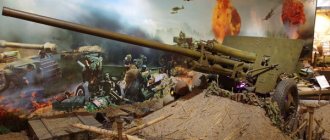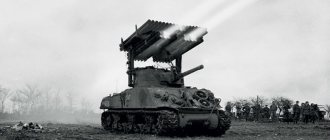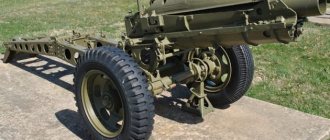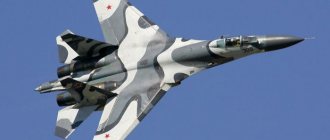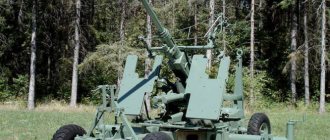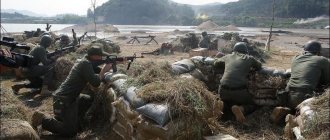Anti-tank self-propelled guns (SU)
Victory over the Poles in 1939, however, did not prevent the Germans from seeing how weak their own tanks were. Especially in the fight against enemy tanks. Therefore, before the attack on France in 1940, the Wehrmacht tank divisions were replenished with Czech 47-mm anti-tank guns mounted on the chassis of the Panzer I tank. The result was a good anti-tank self-propelled gun Panzer Jager I, which, following in the ranks of German tanks, could immediately support them with its more powerful fire.
It was not so much the Soviet tanks that became truly disastrous for the Panzer Jager, but also the Russian open spaces with off-road conditions. The chassis from the Panzer I broke down even on the Austrian autobahns in 1938, and now it completely failed on Russian roads
But if in France the new control system somehow managed to cope with its tasks, then the war in Russia put an end to its combat career. The scale and grandeur of the battles turned out to be different. Therefore, in 1942, it was replaced by a whole family of anti-tank SU “marder” (marten), with a 75-mm cannon, which were produced until the very end of the war.
The 75-mm anti-tank gun, mounted on a chassis from a French tractor, laid the foundation for a whole family of self-propelled guns called “martens”. "Marder" I is a control system based on French cars
“Marder” II is a control system based on the German Panzer P tanks. The first 210 anti-tank self-propelled guns, armed with Russian 76-mm F-22 cannons, were built on the chassis of the new Panzer II D or converted from Flammpanzer II flamethrower tanks
"Marder" III is a control system based on the Czech LT-38 tanks. The “marten” drawn on the left was armed with the Russian F-22 cannon, and the one drawn on the right was armed with the German Pak 40. “Marder” III became the most popular anti-tank control system of the Wehrmacht. Almost 2 thousand of these self-propelled guns were built.
"Hornet" is the most powerful anti-tank gun of the Wehrmacht. It is armed with a six-meter 88-mm cannon
Painting of German shells and mines
Painting Painting of shells and mines has two purposes, protecting the shell of the projectile from corrosion and providing easily perceptible information about the type, purpose and effect of the ammunition. Fuses with a plastic body and an iron shell are painted to protect the glasses from corrosion, and are also painted to protect them from corrosion.
Coloring of German mines, shells and fuses:
The following are painted in a dark green protective color: a)
all main and special-purpose ground artillery shells, except for all armor-piercing and propaganda shells and two types of 37-mm fragmentation tracer grenades intended only for ground fire.
b)
all mines with a steel shell
; c)
fuses with a plastic body covered with a thin iron shell.
All armor-piercing shells, of all calibers, systems and devices,
are painted black are painted yellow
, except for 37-mm fragmentation tracer grenades intended for ground firing from anti-aircraft guns;
such shells are painted in a dark green protective color. The following are painted red: a)
all mines with a shell made of steel or malleable cast iron;
b)
Propaganda shells, the head of which is painted white.
Self-propelled howitzers
Self-propelled howitzers sIG 33 became real “sledgehammers” in the Wehrmacht tank divisions. The weapon, which had crushing power, was initially installed on the chassis of Panzer I tanks in its original form - on an artillery carriage and even with wheels! However, the wheels that were unnecessary in the wheelhouse were soon abandoned. The height of the cabin turned out to be high, which is why on slopes the self-propelled gun could fall on its side. The chassis, designed for only two tankers and a tiny turret with two machine guns, could hardly support a heavy howitzer in a huge wheelhouse with a crew of four.
Model sIG 33 based on Panzer II
And yet, despite all the shortcomings, the first self-propelled howitzer of the Wehrmacht was indispensable in tank divisions. Unlike guns towed by tractors, it opened fire on the move, without wasting time uncoupling the gun and bringing it into firing position. And the self-propelled sIG 33 was especially in demand in the war with Russia, where not only all the Wehrmacht tanks were powerless in the fight against the T-34 and KV, but also the Panzer Jager I anti-tank self-propelled gun, armed with a 47-mm cannon. And the self-propelled 150-mm howitzer sIG 33 could destroy strong fortifications and put new Soviet tanks out of action. Therefore, just as the production of howitzers themselves did not stop until the very end of the war, its self-propelled versions did not leave the assembly line. After Panzer I, the sIG 33 was installed on chassis from Panzer II and Panzer III, but the most widespread production was the production of self-propelled guns (SU) based on the Czech LT-38 tank. Being very different in appearance, they were called differently. The formidable machines of the early series were called “bisons”, the later ones - “grasshoppers”.
In 1943, the Wehrmacht was replenished with two more “insects”. The light 105 mm howitzer based on the Panzer II was called the “wasp”, and the heavy 150 mm howitzer on the Panzer IV was called the “bumblebee”.
Self-propelled 150-mm howitzer "bizon"
Self-propelled 150-mm howitzer "grasshopper"
Self-propelled 150-mm howitzer "bumblebee"
Self-propelled 105-mm howitzer "Osa"
Captured German infantry guns in service in the Red Army
Soviet troops began using captured guns and mortars in July 1941.
But in the first months of the war their use was sporadic and unsystematic. Taking into account the fact that the Red Army was sorely lacking in means of propulsion, and there was nowhere to replenish the supply of shells, captured artillery systems often fired all their available ammunition in one battle, after which they were destroyed or abandoned. The effectiveness of using German captured artillery weapons at the first stage was very low. The calculation skills left much to be desired. In addition, there were no shooting tables or operating instructions translated into Russian.
During Soviet counterattacks at the end of 1941 - beginning of 1942, they managed to capture several hundred German guns and mortars suitable for further use, as well as a supply of ammunition for them.
The organized use of captured artillery began in mid-1942, when the Red Army formed artillery and mortar batteries equipped with 75–150 mm infantry guns, 37–47 mm anti-tank guns, and 81 mm mortars.
In first place in terms of the number of barrels and intensity of use were anti-tank and regimental artillery, as well as mortars. Artillery operating at the front line and coming into direct contact with the enemy always suffered greater losses than artillery firing from indirect positions. In this regard, in the artillery units and subunits of the Red Army leading combat operations, there was a regular shortage of materiel. Moreover, even in 1944, when the industry had already completely rebuilt itself on a military basis and the production volumes of the main types of weapons increased sharply.
After the Red Army began to achieve greater success on the battlefield, the number of artillery batteries equipped with captured guns increased. The artillery units of the Red Army received in increasing numbers not only infantry and anti-tank guns, but also powerful 105–150 mm guns.
German artillery systems were used in combat until the surrender of Germany. After the war, they were in storage for some time. Subsequently, most of them were cut into metal, and the most modern captured guns, which had sufficient service life, were transferred to the allies.
This article will focus on German infantry guns used in the regimental level, intended to provide fire support to infantry units.
Light infantry gun 75 mm le.IG.18
From the first to the last days of the war, the 75 mm 7.5 cm le.IG.18 gun was actively used in the German army. The light gun, created by Rheinmetall-Borsig AG in 1927 for direct artillery support of infantry, is considered one of the best in its class.
Crew of the 7.5 cm le.IG.18 light infantry gun at a firing position.
First of all, the gun was intended to destroy openly located and sheltered infantry, firing points, field artillery and enemy mortars. If necessary, the 75-mm infantry gun could fight enemy armored vehicles.
Unlike guns of a similar purpose that were available in the armies of other countries, the German 75-mm light infantry gun had a very large maximum elevation angle (from −10 to +75°) and separate-case loading with various propellant charge weights.
Light infantry 75 mm gun 7.5 cm le.IG.18 with maximum barrel elevation angle
As a result, it was possible to choose the flight path of a projectile and hit visually unobservable targets hidden in folds of the terrain and on the reverse slopes of hills. As a result, the weapon was highly effective and flexible in use. In fact, it combined the properties of a regimental cannon and a light howitzer.
The weight of the gun in the firing position was 400 kg, thanks to which a crew of six people could roll it quite freely over short distances. If necessary, special straps were used. Weight in stowed position with front end – 1560 kg.
The first version, which entered service with the troops in 1932, was intended for horse-drawn transportation and had wooden wheels with a metal rim and switchable suspension.
In 1937, an improved modification with metal disc wheels equipped with pneumatic tires entered the series. In this case, it was possible to tow by vehicles at speeds of up to 50 km/h.
With a barrel length of 885 mm (11.8 calibers), the initial speed of a 7.5 cm Igr.18 high-explosive fragmentation projectile weighing 6 kg, depending on the propellant charge, could vary from 92 to 212 m/s. The tabulated firing range at the optimal elevation of the firing barrel on charge No. 1 was 810 m, and on charge No. 5 – 3470 m. Rate of fire – 12 rounds/min.
The ammunition included two types of high-explosive fragmentation projectiles and two types of cumulative projectiles, as well as a target designation projectile. The 7.5 cm Igr.18 high-explosive fragmentation projectile was loaded with a charge of cast TNT weighing 700 g, which for better visibility of the explosion contained a smoke-producing capsule with red phosphorus. Projectile 7.5 cm Igr. 18 Al differed in that powdered aluminum was added to the bursting charge, and cast ammonal was used as a bursting charge (in addition to TNT).
A high-explosive fragmentation projectile could penetrate wood-earth field fortifications with a floor thickness of up to 1 m or a brick wall up to 25 cm thick. When a projectile exploded, the area affected by fragments was 12 m to the sides, 6 m forward and 3 m back. When a shell exploded after a ricochet at a height of up to 10 m, the affected area was 15 m to the sides, 10 m forward and 5 m back.
The gun's ammunition did not contain caliber armor-piercing shells, but, as practice has shown, firing high-explosive fragmentation shells on powder charge No. 5, which gave the maximum initial velocity, made it possible to penetrate armor 20–22 mm thick. Thus, at a minimum firing distance, the le.IG.18 cannon could fight light armored vehicles.
To combat more protected tanks, 7.5 cm Igr.38 and 7.5 cm Igr.38HL/A cumulative shells were intended. However, the effective range of fire at an initial projectile speed of 260 m/s did not exceed 400 m. And at a range of more than 800 m, the probability of hitting a moving tank tended to zero.
The armor penetration of a cumulative projectile loaded with 530 g of TNT alloy with hexogen was 85–90 mm normal. Taking into account the large angle of inclination of the frontal armor of the T-34 tank, this was not always enough. But even in the case of penetration, the armor-plated damaging effect of the cumulative jet was weak in most cases. With a reasonable degree of probability, it was possible to hit the “thirty-four” with a cumulative projectile only on the side. In addition, the anti-tank capabilities of the le.IG.18 gun were reduced by the limited horizontal aiming sector (11°), which made it difficult to fire at fast-moving targets.
The 7.5 cm Igr.Deut projectile with a spacer tube was intended to create a clearly visible landmark on the ground. And with the help of an expelling charge at a given point, he threw out 120 brick-colored cardboard circles and 100 red cardboard circles. There was also a projectile for a similar purpose with a smoke-producing composition.
In the Wehrmacht and SS troops, le.IG.18 guns served as regimental, and in some cases, battalion artillery. German infantry and motorized divisions were required to have 20 light infantry guns.
75 mm le.IG.18 cannons were very widely used during the Second World War. As of September 1, 1939, the Wehrmacht had 2,933 light infantry guns and 3,506 thousand rounds for them.
On June 1, 1941, the German armed forces had 4,176 light infantry guns and 7,956 thousand rounds of ammunition for them. At the beginning of March 1945, the Germans had 2594 le.IG.18 units, which were actively used until the end of hostilities.
Light 75 mm guns were used very intensively. In 1942, they spent 6,200 thousand rounds, in 1943 - 7,796 thousand, in 1944 - 10,817 thousand, and in January - February 1945 - 1,750 thousand rounds.
Taking into account the fact that 75-mm le.IG.18 cannons were often located in combat formations of infantry units, their losses were very significant. For example, in the period from December 1, 1941 to February 28, 1942, 510 guns of this type were lost, and from October 1944 to February 1945 - 1,131 guns. A significant part of the guns lost by the Germans went to the Red Army.
The first photographs of captured 75 mm le.IG.18 cannons date back to August 1941. However, a noticeable number of such guns and ammunition for them were captured by the Red Army at the end of 1941 - beginning of 1942.
The captured 7.5 cm le.IG.18 were used in the same way as the Soviet 76-mm regimental guns of the 1927 model. Several hundred 75 mm guns made in Germany in 1942–1943. were used to form artillery batteries and divisions of 4–5 guns in rifle brigades, rifle, motorized rifle and cavalry regiments.
In the Red Army, captured 75-mm le.IG.18 were primarily fired at direct fire. This was due to the fact that for effective indirect fire, personnel were required to have good knowledge of artillery. And mounted shooting was difficult to master for insufficiently trained personnel. However, in 1943, the GAU produced for the “75-mm German light infantry gun mod. 18" shooting tables and operating instructions translated into Russian.
In total, our troops captured about 1000 serviceable 7.5 cm le.IG.18 guns. Some of them were subsequently transferred to the armed forces of friendly states.
For example, after the formation of the German Democratic Republic, 75-mm infantry guns were used in the training of the barracks people's police, which later became the core of the National People's Army of the GDR.
Soon after the victory over Nazi Germany, the Soviet leadership authorized the transfer of captured 7.5 cm le.IG.18 infantry guns and ammunition to the Chinese communists waging an armed struggle against the Kuomintang.
The 7.5 cm le.IG.18 gun is on display at the Military Museum of the Chinese Revolution.
Subsequently, several dozen of these guns were used by Chinese people's volunteers during the fighting in Korea. Due to its lighter weight, the German-made 75-mm infantry gun was better suited to the specific conditions of the Korean Peninsula than the much heavier Soviet 76-mm regimental gun mod. 1943
Infantry 75 mm gun 7.5 cm IG 42
In general, the 7.5 cm le.IG.18 light infantry gun was quite satisfactory to the German command.
However, the weapon, developed in the late 1920s, no longer fully met modern requirements. It was extremely desirable to increase the firing sector in the horizontal plane, increase the combat rate of fire and direct shot range. In 1941, Krupp designers presented the first prototype of a 75-mm regimental gun, which later received the designation 7.5 cm IG 42 (German: 7.5 cm Infanteriegeschütz 42). However, at that time, the Wehrmacht command believed that the war could be won with existing weapons. And they didn’t show much interest in the new gun. Subsequently, mass production of the IG 42 gun was launched with a great delay. And the first batch of 39 IG42 guns was sent to the front in October 1944.
Infantry 75 mm gun 7.5 cm IG 42
The 21-caliber gun barrel was equipped with a muzzle brake. In a longer barrel, the high-explosive fragmentation projectile of the le.IG.18 infantry gun accelerated to 280 m/s and had a maximum firing range of 5150 m. Thanks to the increased initial speed, the direct shot range increased, which also had a beneficial effect on accuracy.
The carriage with sliding tubular frames was very reminiscent of the carriage of the 7.5 cm Geb.G mountain gun. 36 (German: 7.5 cm Gebirgsgeschütz 36). The maximum vertical aiming angle was 32°. And, unlike le.IG.18, the IG 42 infantry gun did not have howitzer properties. But the guidance sector in the horizontal plane increased to 35°.
The use of a semi-automatic wedge bolt made it possible to increase the rate of fire to 20 rounds/min. At the same time, the mass of the gun in firing position was 590 kg (190 kg more than le.IG.18).
Compared to the production volumes of the 75 mm le.IG.18 guns, relatively few IG 42 guns were produced - approximately 1,450 units.
Infantry 75 mm gun 7.5 cm IG 37
The IG 37 gun was a cheaper version of the IG 42. A number of sources say that it was obtained by placing the IG 42 barrel on the carriage of a Soviet 45-mm anti-tank gun of the 1937 model. But there is also information that for the production of IG 37, carriages of German 37-mm anti-tank guns 3.7 cm Pak 35/36 were used.
Infantry 75 mm gun 7.5 cm IG 37
The ballistic characteristics and rate of fire of the IG 37 remained the same as that of the IG 42. The use of anti-tank gun carriages did not allow firing with a barrel elevation angle of more than 25°, while the maximum firing range reached 4800 m. The horizontal firing sector was 60°. Weight in combat position - 530 kg.
Serial production of the 7.5 cm IG 37 guns began in May 1944, and the first batch of 84 infantry 75 mm IG37 guns was sent to the front in June 1944. In March 1945, the troops had a little more than 1,300 such guns.
A very revealing comparison of the German 7.5 cm IG 37 infantry gun with the Soviet 76.2 mm regimental gun mod. 1943, which was also obtained by placing a 76.2 mm barrel with weak ballistics on the carriage of a 45 mm anti-tank gun mod. 1942
The Soviet gun fired high-explosive fragmentation shells, which were 200 g heavier than the German ones. The gun itself weighed 70 kg more, and the maximum firing range at the same vertical angle was 4200 m. The breech of the 76.2-mm regimental gun mod. 1943 repeated the bolt of the 76-mm regimental gun mod. 1927. Therefore, the rate of fire did not exceed 12 rounds/min.
The ammunition of the Soviet regimental gun included shots not only from high-explosive fragmentation grenades, but also caliber armor-piercing shells, cumulative shells (armor penetration 70–75 mm), shrapnel and buckshot.
In turn, the Germans captured more than 2,000 of our 76.2-mm regimental guns mod. 1927 and arr. 1943 And they started producing high-explosive fragmentation and cumulative shells for them.
Subsequently, our troops recaptured approximately a hundred guns. Due to their higher armor penetration, captured German-made artillery rounds with 76.2 mm cumulative grenades were in great demand in the Red Army.
75 mm gun 7.5 cm PaK 97/38
In France and Poland, the Wehrmacht captured several thousand French-made 75-mm Canon de 75 mle 1897 (Mle. 1897) divisional guns and more than 7.5 million rounds for them.
Gun Mle. 1897 was born in 1897. And it became the first mass-produced rapid-fire cannon equipped with recoil devices. But by the beginning of World War II, this artillery system was hopelessly outdated. Guns Mle. 1897 captured in France were designated 7.5 cm FK231 (f), Polish - 7.5 cm FK97(p). Initially, the Germans used them in their original form in the “second line” divisions, as well as in coastal defense on the coasts of Norway and France. Due to the acute shortage of anti-tank guns capable of fighting tanks with anti-ballistic armor, the German command at the end of 1941 remembered the captured French divisions.
It was difficult to use these outdated divisional guns to fight tanks, even with an armor-piercing projectile in the ammunition load, due to the small horizontal guidance angle (6°) allowed by the single-beam carriage. The lack of suspension allowed towing at a speed of no more than 12 km/h. In addition, the German military was not satisfied with a weapon suitable only for horse-drawn traction.
German designers found a solution: the swinging part of the 75-mm French Mle cannon. 1897 was placed on the carriage of the German 50-mm anti-tank gun 5.0 cm Pak. 38 with sliding tubular frames and wheel travel, providing the possibility of towing with mechanized traction. To reduce recoil, the barrel was equipped with a muzzle brake. The Franco-German “hybrid” was adopted under the designation 7.5 cm Pak. 97/38.
75 mm gun 7.5 cm Pak.
97/38 in the firing position The mass of the gun in the firing position was 1190 kg.
Vertical aiming angles from −8° to +25°, in the horizontal plane –60°. The 75 mm Pak 97/38 gun retained the Mle piston breech. 1897, which provided a rate of fire of 10–12 rounds/min. The ammunition included unitary rounds of German, French and Polish production. The maximum firing range was 9800 m. Captured high-explosive fragmentation rounds were used in their original form and converted into cumulative ones.
An armor-piercing projectile weighing 6.8 kg left a barrel 2721 mm long with an initial speed of 570 m/s. And at a distance of 100 m at a meeting angle of 60° it could penetrate 61 mm of armor. Such armor penetration was certainly not enough to confidently fight the T-34 and KV-1 tanks. In connection with this, 7.5 cm Gr.38/97 Hl/A(f), 7.5 cm Gr.38/97 Hl/B(f) cumulative projectiles and 7.5 cm Gr cumulative tracer were introduced into the ammunition load. 97/38 Hl/C(f). Their initial speed was 450–470 m/s. The effective firing range at moving targets is up to 500 m. According to German data, cumulative shells normally penetrated 80–90 mm of armor.
Manufactured by Pak. 97/38 began in February 1942. And it was stopped in July 1943. Moreover, the last 160 guns were made on a Pak gun carriage. 40, they were designated Pak. 97/40. Compared to Pak. 97/38, the new artillery system became heavier (1425 versus 1270 kg), but the ballistic data remained the same. In just one and a half years of serial production, 3712 Pak were manufactured. 97/38 and Pak. 97/40.
Initially, 75-mm guns entered service with tank destroyer divisions.
But it soon became clear that the “French-German hybrid” performed poorly as an anti-tank weapon. This was primarily due to the relatively low initial speed of cumulative projectiles, which negatively affected the direct shot range and shooting accuracy. Although German specialists managed to achieve almost maximum armor penetration for a 75-mm cumulative projectile, this was often not enough to confidently overcome the frontal armor of the T-34 tank.
In terms of anti-tank capabilities, the 7.5 cm Pak gun. 97/38 was not much superior to the infantry guns IG 37 and IG 42, but at the same time its mass in combat position was much greater. In the summer of 1943, after the start of mass production of the 7.5 cm Pak. 40, most of the Pak guns. 97/38 were withdrawn from anti-tank divisions.
The 75-mm “hybrid” guns remaining on the front line were transferred to field artillery, and they mainly fired at manpower and light wood-earth fortifications. In addition to the 75mm high-explosive fragmentation grenade rounds captured in France and Poland, the Germans fired approximately 2.8 million more such rounds.
In addition to the Eastern Front, 75-mm guns were placed in long-term fortified positions on the Atlantic Wall. In addition to the Wehrmacht 7.5 cm Pak. 97/38 were delivered to Romania, as well as Finland. As of March 1, 1945, Wehrmacht units still had 122 Pak guns. 97/38
Several dozen 7.5 cm Pak guns. 97/38 were captured by the Red Army.
Captured 75-mm guns, provided they had ammunition and means of propulsion, were used to a limited extent in Soviet regimental and divisional artillery. Since there were no shooting tables for them, Pak. 97/38 mainly fired at visually observed targets.
150 mm heavy infantry gun 15 cm sIG. 33
In addition to 75 mm guns, German infantry regiments were given 150 mm guns from 1933 onwards.
The regimental artillery company according to the states in 1940 had 6 light 7.5 cm le.IG.18 guns and two heavy 15 cm sIG guns. 33 (German: 15 cm schweres Infanterie Geschütz 33). Although the design has 15 cm sIG. 33 conservative technical solutions were used, specialists from Rheinmetall-Borsig AG were able to provide the gun with very good characteristics. The maximum elevation angle was 73º - that is, the gun was a full-fledged howitzer. The range of horizontal aiming angles, despite the simple single-beam carriage, was also quite large - 11.5º to the right and left.
150 mm heavy infantry gun 15 cm sIG.
33 The gun was produced in two versions: for mechanized and horse-drawn traction.
In the first case, cast light-alloy wheels with steel edgings had rubber tires. Torsion bar suspension allowed mechanical towing at a speed of 35 km/h.
In the stowed position, the version for mechanized traction weighed 1825 kg, and the version for horse traction weighed 1700 kg. Although the gun turned out to be quite light for such a caliber, at the end of the 30s the Germans made an attempt to lighten the gun. And they partially replaced steel in the carriage design with light alloys. After which the gun became lighter by about 150 kg.
However, due to the shortage of light metals after the outbreak of World War II, the production of cast aluminum alloy carriages was discontinued.
The standard towing device is sIG. 33 in motorized and tank divisions was the 3-ton half-track tractor Sd.Kfz. eleven.
Captured tractors were also often used: the French Unic P107 and the Soviet Komsomolets. Most often, captured tractors were used to tow guns that were originally designed for horse traction.
The gun fired shots with separate cartridge loading. And it was equipped with a piston valve. The crew, consisting of seven people, could provide fire at a rate of fire of up to 4 rounds/min.
15 cm sIG gun. 33 had a fairly wide range of ammunition. But high-explosive fragmentation rounds with separate cartridge loading were considered the main ones in the ammunition load.
High explosive fragmentation grenades 15 cm IGr. 33 and 15 cm IGr. 38 weighed 38 kg and contained 7.8–8.3 kg of TNT or amatol. When the fuse was set to instant action, the lethal fragments scattered 20 m forward, 40–45 m to the side and 5 meters back.
The high-explosive effect of the shells was more than enough to destroy light field fortifications. The shells penetrated shelters up to three meters thick made of earth and logs.
The crew fires from a 150 mm 15 cm sIG heavy infantry gun.
33 Brass or steel cartridges, in addition to the main powder charge, contained up to six weighted bundles of diglycol or nitroglycerin powder.
When firing 15 cm IGr shells. 33 and 15 cm IGr. 38 on the 1st (minimum) charge the initial speed was 125 m/s, the maximum firing range was 1475 m. On the 6th (maximum) charge it was 240 m/s and 4700 m, respectively. Also for shooting from 15 cm sIG. 33, 15 cm IGr38 Nb smoke shells weighing 40 kg were used. Such a projectile created a smoke cloud with a diameter of about 50 m, the average smoke time was 40 s.
Incendiary projectile 15 cm IGr. 38 Br was equipped with thermite segments, which were scattered on the ground with an expelling powder charge.
At the end of 1941, the troops began to receive 15 cm IGr cumulative shells. 39 HL/A with normal armor resistance of 160 mm. With a mass of 24.6 kg, the projectile was loaded with 4.14 kg of hexogen. The tabulated firing range of such a projectile was 1800 m, the effective range was no more than 400 m.
After Stielgranate 42 over-caliber finned mines began to be supplied to the active army in 1942, the sIG infantry gun. 33 could be used as a heavy mortar.
The 300 mm ammunition weighing 90 kg contained 54 kg of ammatol. With an initial speed of 105 m/s, the maximum firing range slightly exceeded 1000 m. The mine, equipped with an instant fuse, was used to clear minefields and barbed wire obstacles, as well as to destroy long-term fortifications.
For comparison, the 210 mm 21 cm Gr. 18 Stg, designed for firing from a 21 cm Gr mortar. 18, weighed 113 kg and contained 17.35 kg of TNT. In terms of destructive effect, the Stielgranate 42 over-caliber mine was approximately equivalent to the Soviet OFAB-100 aerial bomb, the explosion of which created a crater with a diameter of 5 m and a depth of 1.7 m.
In September 1939, the Wehrmacht had over 400 heavy infantry guns. In total, approximately 4,600 guns were fired. By June 1, 1941, the Wehrmacht had 867 heavy infantry guns and 1,264 thousand shells for them. In March 1945, 1,539 15 cm sIG heavy infantry guns were in service. 33.
Combat use experience has demonstrated the high combat effectiveness of 150 mm infantry guns. At the same time, the relatively large weight made it difficult for crews to roll onto the battlefield.
A completely logical solution to increase mobility was the creation of a self-propelled version. The first such self-propelled gun Sturmpanzer I on the chassis of the Pz.Kpfw light tank. I Ausf. B appeared in January 1940. Subsequently, the Sturmpanzer II self-propelled guns (on the Pz.Kpfw. II chassis) and StuIG were armed with 150-mm infantry guns. 33B (based on Pz. Kpfw. III). Since 1943, companies of infantry guns in tank and panzergrenadier divisions were rearmed with Grille self-propelled guns (on the Pz.Kpfw. 38(t) chassis) - six units per company. At the same time, all towed guns - both light and heavy - were confiscated from these companies.
The use of 150 mm guns in German infantry regiments was an unprecedented step. During the Second World War, no other army had such powerful artillery systems in its infantry units. The firepower of these guns gave the German infantry regiments a tangible advantage on the battlefield and allowed them to independently solve tasks for which the armies of other countries had to use divisional artillery.
The regiment commander had the opportunity to use his “own” artillery to hit targets that were inaccessible to machine guns and mortars. Platoons of light 75 mm infantry guns could be assigned to battalions, while heavy 150 mm guns were always used at the regimental level.
Infantry guns were placed in close proximity to the front line, which during offensive operations reduced reaction time and made it possible to suppress exposed targets as quickly as possible. At the same time, 15 cm sIG guns. 33 had a relatively short firing range and could not effectively conduct counter-battery combat, as a result of which they often suffered losses.
In the event of a rapid enemy advance, evacuate the 150 mm sIG. 33 was more difficult than the 75 mm le.IG.18, as a result of which they were often captured by the Red Army.
Captured 15 cm sIG infantry gun.
33 in testing. USSR, 1942. The Red Army managed to capture several hundred 150 mm sIG guns. 33 and a significant amount of ammunition for them. Initially, they were used unorganized, as a supernumerary means of fire reinforcement for regiments and divisions. At the same time, as in the case of 75-mm light infantry guns, fire was fired only at visually observable targets. This was due to the fact that mounted shooting from heavy infantry guns required a good knowledge of the characteristics of charges, the properties of ammunition and their markings.
At the end of 1942, captured 15 cm sIG. 33 began to be sent to mixed divisions of artillery regiments attached to rifle divisions. Where they replaced 122 mm howitzers. To enable the full use of 150 mm guns, firing tables and operating instructions were issued, and the crews underwent the necessary training.
However, such a replacement was not entirely equivalent. The power of the 150-mm projectile was, of course, higher. But in terms of firing range, the 150-mm heavy infantry gun was inferior not only to the new 122-mm M-30 howitzer, but also to the modernized 122-mm mod. 1909/37 and 122 mm mod. 1910/30
Despite their short firing range, 150-mm German-made guns were used by the Red Army until the last days of the war. Their best qualities were revealed during offensive operations, in cases where it was necessary to suppress well-fortified enemy resistance units.
The Voroshilovets tractor is towing a damaged German 150-mm self-propelled gun to the rear.
Apparently, captured self-propelled artillery mounts with 15 cm sIG guns. 33 also found use in the Red Army.
Yugoslav partisans captured approximately two dozen 150 mm sIG infantry guns in 1944. 33. And they were actively used in combat operations against the Germans and Croats.
15 cm sIG gun. 33 at the Belgrade War Museum
In the post-war period, German 15 cm sIG guns. 33 were in service in a number of Eastern European countries until the mid-1950s. According to some reports, 150-mm infantry guns could be used by Chinese people's volunteers during the fighting on the Korean Peninsula.
In any case, one 15 cm sIG gun. 33 is on display at the Beijing Military Museum of the Chinese Revolution.
To be continued…
Assault guns
It’s hard to believe, but entering World War II, the German infantry division was not much different from the Kaiser’s divisions in terms of technical equipment. All Wehrmacht equipment was collected in tank divisions, and equipment, artillery, food and ammunition in the infantry were still dragged by horses. The only combat vehicles of the infantry divisions were the Sturm Geschutz (StuG) assault guns. These were fully armored, turretless vehicles with a short 75mm infantry cannon mounted in the hull of a Panzer III tank.
In short-lived companies in the West, the StuG III performed well. But in the fiercest battles that flared up with unprecedented force on the Eastern Front, a more powerful weapon was required for the assault self-propelled gun.
StuG III T-35
In the Battles of Stalingra in 1942, the StuIG 33 self-propelled gun, armed with a 150 mm cannon, was tested. But the powerful weapon in the huge wheelhouse greatly overweighted the chassis of the Troika. Therefore, on the eve of the terrible events near Kursk, the 150-mm cannon was installed on a stronger chassis from the Panzer IV tank (self-propelled gun "brummbar"), and in the wheelhouse of the "Sturmgeschutz" it was possible to place a light 105-mm infantry howitzer (self-propelled gun StuH 42). The 88-mm Ferdinand assault guns also made their debut at the Kursk Bulge, and turned out to be quite good tank destroyers.
But even with new, more powerful assault guns, the Wehrmacht in 1943 failed to turn the tide of the war in its favor.
The “Assault Tiger”, armed with a 380-mm anti-submarine rocket launcher, became a real curiosity in the family of assault SUs. The destiny of this assault monster, which appeared in 1944, was the destruction of the rebellious Warsaw and the shelling of accumulations of American equipment on the Western Front. It was not a sin to take a photo against the backdrop of such a “handsome man.”
"Storm Tiger"
Eighteen Sturmtigers, of course, could not turn the tide of the war in Germany's favor. But they went down in history with two spectacular hits. Once - into a large bunker occupied by the enemy on the Siegfried Line, another time - into a concentration of American tanks, when three Shermans almost evaporated and five more were destroyed.
StuIG 33, first tested in Stalingrad, was also used in the Wehrmacht tank divisions at Kursk
The StuH 42, armed with a 105 mm gun, was sometimes called “artishturm”, or even “Ferdinand” itself.
The Ferdinand assault gun, like the StuG III, very quickly turned into a real tank destroyer. Lacking a machine gun, the clumsy Ferdinand was very vulnerable in close combat
"Brummbar" (grumpy bear) got its name from its menacing appearance and the grunting engine from the Panzer IV. The defensive machine gun pictured here appeared on later SUs.

